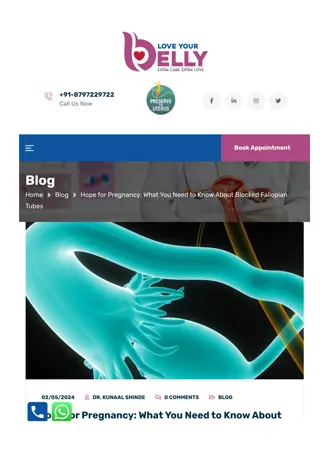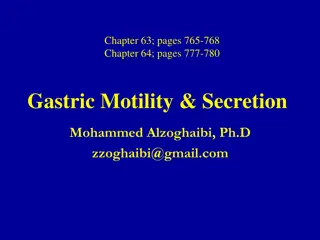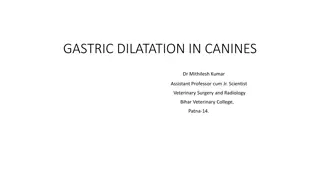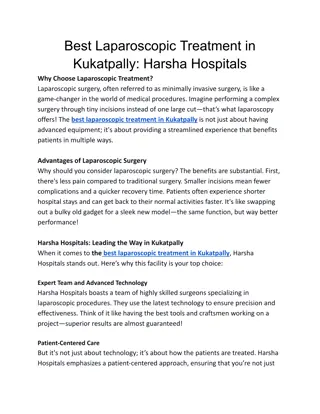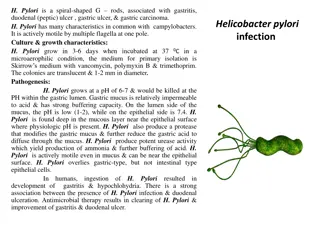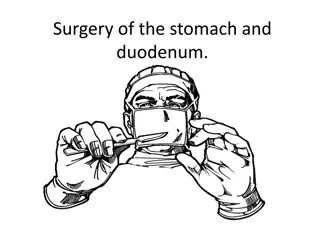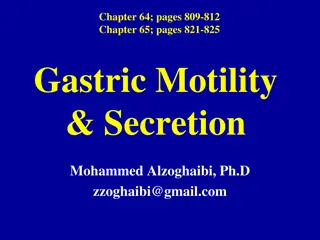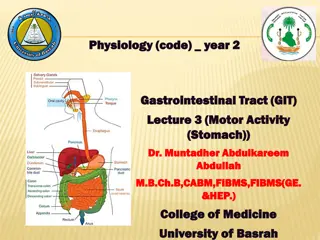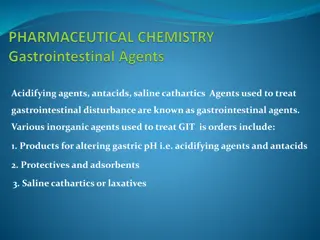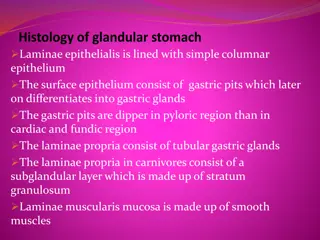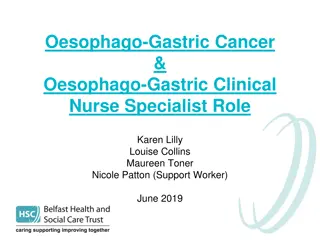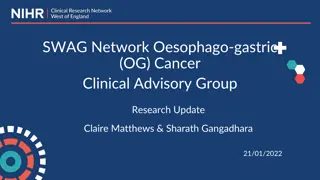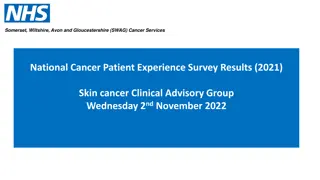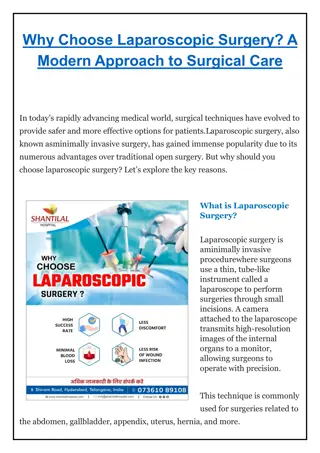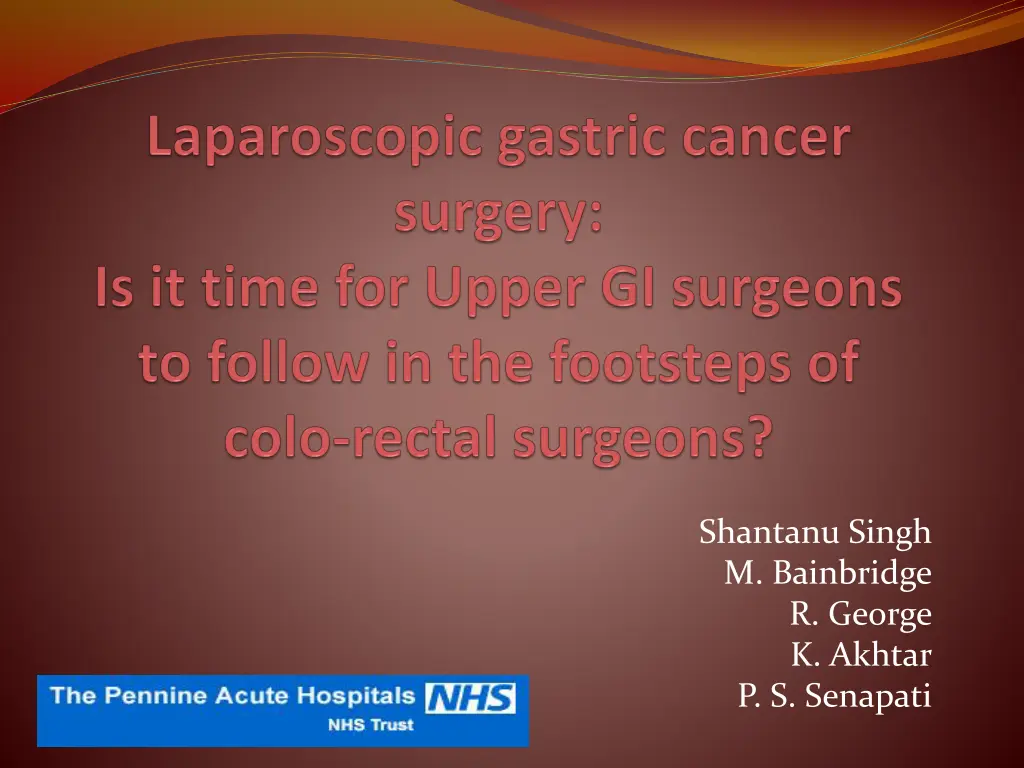
Laparoscopic Gastric Cancer Surgery Outcomes Comparison
Explore the outcomes of laparoscopic versus conventional open gastric cancer surgery, including lymph node harvest, resection margin clearance, morbidity and mortality, disease-free survival, operative time, conversion rate, blood loss, post-op analgesia, ICU and hospital stay. Learn about the evolution of laparoscopic surgery and the findings from national audits and studies on safety and efficacy.
Download Presentation

Please find below an Image/Link to download the presentation.
The content on the website is provided AS IS for your information and personal use only. It may not be sold, licensed, or shared on other websites without obtaining consent from the author. If you encounter any issues during the download, it is possible that the publisher has removed the file from their server.
You are allowed to download the files provided on this website for personal or commercial use, subject to the condition that they are used lawfully. All files are the property of their respective owners.
The content on the website is provided AS IS for your information and personal use only. It may not be sold, licensed, or shared on other websites without obtaining consent from the author.
E N D
Presentation Transcript
Shantanu Singh M. Bainbridge R. George K. Akhtar P. S. Senapati
BACKGROUND first lap Gastrectomy 1991. first lap Colectomy- 1990 Multiple trials to prove safety. Azagra et al (first European) 1993 NICE 2000: Most of the evidence from Asia Lap colectomy should only be a part of RCT One in Europe (N= 30 lap) Huscher et al in 2005 One meta analysis Two NRCTs A meta-analysis (n = 1536) from four RCTs. 19 RCT (4 RCTs 12 NRCT s) Four case series NICE 2006 NICE 2008 : Evidence on the safety and efficacy of lap gastrectomy appears adequate to support . lap resection as an alternative to open surgery The National Training Programme Training centres in 16 hospitals Further publication on long term outcome & Survival Surgeons to submit data in database 2007
BACKGROUND 2006 to 2010 Proportion of LCS nationally increased from 10.4% to 23% Only 13% LG (most of these by hybrid approach - National O-G audit 2010) 25% (5,600) of patients would be suitable for LCS Over 460 surgeons needed to support 221 trainees and trainers involved with the programme Goal to train 250 consultants within 5 years
NICE : July 2008 Lower incidence (8,000 gastric Vs. 30,000 Colon yearly incidence in UK) LG slowly accepted in the West Level of lymph node dissection Paucity of Long term outcome data Main controversy Trained & Expert in advance techniques Experienced mentor submit data to the central database for audit Operating Surgeon The yield of LN did not differ significantly The National O-G Cancer Audit 2010
Background Recent National audit did not show significant difference in LN harvest (concern raised by NICE). Our snap shot of QOL favours the lap group We have been performing this procedure since 2004 .
Aim To compare the outcome of totally laparoscopic and conventional opengastriccancersurgery. Primary outcome measure Lymph node harvest Resection margin clearance Morbidity & mortality Disease free survival Secondary Outcome measure Operative time Conversion rate Blood loss & transfusion Post op analgesia ITU & Hospital Stay
Methods A prospective database of all gastric cancer surgery with curative intention Sept 2003 to Sept 2010 Performed by two surgeons Population of 800,000 A total of 129 operations (72 Totally lap & 57 open). Patients were followed up till 28thFebruary 2011. Median follow up Lap 562 and Open- 695 days SPSS was used for statistical analysis & Kaplan-Meier curve was used for survival analysis.
Operation 60 50 40 Subtotal 30 56 Total (78%) 20 38 (67%) 10 19 (33%) 16 (22%) 0 lap (n=72) open (n=57)
Age Distribution 60% 49% 50% 38% 40% t = 0.0248 32% 30% Lap (Median 74) 26% 21% Open (Median 72) 20% 11% 7% 10% 5% 5% 3% 2% 1% 0% 0% 0% < 40 41 - 50 51 - 60 61 - 70 71 - 80 81 - 90 > 90
Gender 80 70 60 32 Female 20 50 Male 40 30 40 37 20 10 0 Lap Open
Change of Practice 25 20 15 16 18 1 5 Lap 10 14 6 Open 13 5 0 12 10 7 4 9 7 0 5 200320042005200620072008 2 2009 2010
ASA 40 47% 35 42% 30 25 37% 37% 20 15 19% 10 6% 7% 4% 5 1% 0 0 ASA 1 4 4 ASA 2 34 21 ASA 3 30 21 ASA 4 1 0 N/A 3 11 LAP OPEN
Pathological Staging (%) 50% 46% 44% 45% 40% 35% 28% 28% 30% Lap 25% 19% Open 17% 20% 15% 8% 7% 10% 3% 5% 0% 0% Stage 0 Stage 1 Stage 2 Stage 3 Stage 4
RESECTION MARGIN (%) LAP OPEN R0 96% 82.5% R1 4% 17.5% T 0.0194
LYMPH NODE HARVEST (Median) 60 P= 0.5197 50 49 45 40 30 MEDIAN MEAN 20 10 15.5 15 0 0 0 LAP OPEN
LYMPH NODE HARVEST (MEDIAN) 16.5 P= 0.2383 P= 0.4632 16 15.5 15 14.5 LAP 14 16 16 OPEN 13.5 15 13 13.5 12.5 12 SUB TOTAL
STAGED (MDIAN) LYMPH NODE HARVEST 40 35 30 25 LAP 20 37 OPEN 15 10 19 18 18 17 17 14.5 14.5 5 6 0 0 STAGE 0 STAGE 1 STAGE 2 STAGE 3 STAGE 4
Operative Time Time in min. 700 P = 0.2963 P= 0.0021 620 600 540 525 500 437 400 360 MEDIAN 300 296 290 MEAN 269 200 194 190 160 130 100 284 245 342 298 0 Lap subtotal Open subtotal Lap total Open total Lap= 299.5 min. & Open = 286 min, (p= 0.0876)
Conversion (%) SUB-TOTAL TOTAL Converted 23 25 75 77 Not converted SUBTOTAL TOTAL BLEEDING 3 1 ADHESION 3 1 BULKY NTUMOR 3 0 INFILTRATION 2 1 OTHER 2 1
BLOOD LOSS (MEDIAN in ml.) 800 700 P= 0.0006 600 500 LAP 400 725 OPEN 300 200 305 100 0 BLOOD LOSS 95% confidence interval = -589.9 to -172.2
BLOOD LOSS 1800 P=0.0063 P= 0.1459 1600 1600 1500 1500 1500 1400 1200 1000 900 800 792 850 725 600 551 400 400 398 450 300 200 100 50 50 0 LAP SUB OPEN SUB LAP TOT OPEN TOTAL
BLOOD TRANSFUSION (UNIT) LAP OPEN 0.55 0.16 0.76 0.16 MEAN 0.431 P Value
POST OP. ANALGESIA 120% 100% 0 80% 47% PCA 60% 100% EPIDURAL 40% 53% 20% 0% LAP OPEN
HDU / ITU STAY Median 3.5 P=0.9454 3 2.5 2 LAP 1.5 3 OPEN 1 2 0.5 0 HDU STAY (In Days) 10 Patients in lap group did not need HDU/ ITU admission at all. All patients of open group were admitted in HDU/ ITU.
HOSPITAL STAY (MEDIAN) 14 P=0.2207 12 10 8 LAP 13 6 OPEN 10 4 2 0 HOSP STAY (In Days) Social stay in hospital also included No significant difference in subgroup
COMPLICATIONS LAP SUB (n=56) OPEN SUB (n=19) LAP TOTAL (n=16) OPEN TOTAL (n=38) COMPLICATIO N 14 3 7 14 (25%) (19%) (44%) (50%) NO 42 13 9 14 COMPLICATIO N (75%) (81%) (56%) (50%) LEAK 1 0 0 2 CHEST 3 1 3 2 WOUND, PORT INF 5 1 2 7 OTHER 5 1 2 3
IN HOSPITAL MORTALITY 6.00% 5.00% 4.00% LAP 3.00% 5.50% OPEN 2.00% 3.70% 1.00% 0.00% MORTALITY
IN HOSPITAL MORTALITY OPEN SUB (n= 19) LAP TOT (n=16) OPEN TOT (n=38) LAP SUB (n= 56) LAP (n=72) OPEN (n=57) 4 2 3 1 2 0 (5.3%) (6.3%) (5.3%) (5.5%) (3.7%)
DISEASE FREE SURVIVAL LAP VS OPEN Stage wise survival curve comparison - No significant difference P value 0.8472 95% CI of ratio 0.5912 to 1.897 Median Survival undefined
Actual Disease Free Survival 100.0% 80.0% 60.0% 85.5% 81.5% 40.0% 34.3% 53.3% 20.0% 0.0% 1 year 3 year LAP OPEN
SUMMARY & CONCLUSION SIGNIFICANT DIFFERANCE Blood loss Operating time in total gastrectomy TREND More R0 resection PCA use in Lap group Less HDU/ITU utilization NO DIFFERANCE LN Harvest Post op complication In hospital mortality Short & medium term disease free survival
CONCLUSION Above results reveal the oncological adequacy of laparoscopic gastric cancer surgery is comparable with conventional open surgery.
These results need to be revalidated by Multicentre RCT Long term survival Quality of life At present many centres in UK are performing laparoscopic gastrectomy & can be part of the trial. While awaiting results ( a time consuming process) competent surgeons & centres can provide structured training programme & mentorship, as done by our Colo-rectal colleague.





